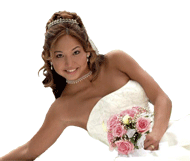

In medieval England, guests brought small cakes and piled them on top of each other in the center of a table. The bride and groom then attempted to kiss over them without knocking it over. If they were successful, a lifetime of good fortune would follow.
It was a French baker who conceived the idea of icing all the small cakes to make one large cake.
The three tier Wedding Cake is thought to have been based on the unusual shape of the spire of Saint Bride's Church in London.
One of the traditions surrounding the tiered wedding cake says that the bottom layer of a wedding cake represents the couple as a family unit, the top layer represents the couple and each layer in between represent a child that the couple hope to have.
Traditionally the first cut was made by the bride to ensure the marriage would be blessed by children.
The traditional English wedding cake is a fruitcake, usually made with raisins, ground almonds, cherries and marzipan. The top layer of the wedding cake is called the "christening cake" which the couple saves for the baptism of their first child. Some couples save the cake for their first anniversary to share with one another.



Today, the groom’s cake is usually a dark color in keeping with the fruitcake tradition, a chocolate cake being the most common. If the bride orders the groom’s cake she will normally choose a design (such as a car or train) which represents the groom’s personality, often keeping the design of the groom’s cake a secret. The groom’s cake is one way for the groom to have his own special part of the reception.
Wedding Cakes






























